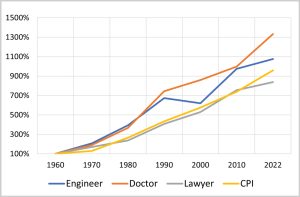A robust post-pandemic job market has triggered a high demand for design and construction expertise. In addition, an influx of federal funding further heightens demand.
At events such as the Winter or Summer ACEC Coalition Meetings, many executives from the industry’s top structural engineering firms often raise recruitment and retention concerns. Unfortunately, these challenges now confront firms of all sizes in nearly every region across the country.
Rather than try to out-recruit the competition, structural design firms should consider alternative strategies – from identifying the potential contributions of non-engineers to adopting Artificial Intelligence technologies – to meet our clients’ growing, increasingly complex needs.
How to Bring New Talent into the Profession
Demand for structural engineers increases as the baby boomer generation hits retirement age. To backfill senior technical and leadership positions, firms often rely on engineers with 10 to 15 years of experience. But this demographic is unusually small as many young engineers left the profession 10-15 years ago during the Great Recession when entry-level positions were fewer in number.
There’s no single solution for how to recruit talent. However, increased salaries, better benefit packages, internal and external training opportunities, flexible hours, and remote work opportunities are all effective.
But if most firms are looking to fill holes in their roster, recruiting talent from within the industry will not solve the overall talent gap. So, how can we attract new talent into the occupation? Or, how can we increase production with current staffing levels?
Compensation Review Reveals Industry-Wide Challenges
Samuel C. Florman’s 1976 book, The Existential Pleasures of Engineering, describes the century from 1850 to 1950 as The Golden Age of Engineering. At a high level, engineering remains a respected and valued field – but the golden years are behind us.
U.S. Bureau of Labor Statistics (BLS) data shows that civil engineering salaries have tracked pretty closely with inflation, growing proportionally at the same rate as the salaries of other prestigious professions like doctors and lawyers. For example, as shown in the Table, the Consumer Price Index rose approximately 960% from January 1960 to January 2022, while an average civil engineer’s salary rose 1076%. The picture is not so rosy, however, for the industry’s entry-level staff. The target demographic for many firms’ recruitment efforts is, on average, not compensated as well as their peers in fields that have recently experienced soaring profits.
According to salary data compiled by Michigan Technological University, civil engineering graduates enter the workforce with a salary of $20,000 per year less than robotics engineers. In addition, they earn $16,000 per year less than computer hardware engineers and $10,000 per year less than industrial and manufacturing engineers. When selecting a field of study, first-year engineering students are potentially deterred by these salary figures. Young engineers are, perhaps, more likely to seek alternative career paths if compensation cannot keep pace with the earnings of their peers.
Recruiting and Utilizing Non-Engineers
Do all staff members need to be trained, licensed engineers? Maybe we can grow our talent pool by recruiting problem solvers from other industries to fill certain roles. For example, it is common to hear that a recent civil engineering graduate took a job with a contractor or a promising young engineer left consulting to work in-house as an owner’s representative for a recent client. It is much less common to hear of a construction engineer joining an engineering firm.
Could a construction engineer be trained to lead a project’s construction services phase? Many already understand how to read engineering drawings and know their way around a construction site. However, with proper coaching from the lead designers, construction-oriented staff members may be able to relieve licensed professionals from these duties.
Do More with Less
Over the past decade, advanced processing capabilities have given rise to several logic-based Artificial Intelligence (AI) systems that can improve the accuracy, detail, and cost-effectiveness of structural designs.
Many workforces bemoan automation as contributing to job losses. But AI systems and machine learning applications can enable structural engineering firms to maximize their resources. For example, faster and more-reliable calculations allow designers to shoulder greater assignments without becoming overburdened.
Training on emerging AI technologies is essential for many young engineers’ long-term career growth. By cultivating a culture of learning, structural design firms can keep their staff on the leading edge. In addition, employees who recognize that their company is truly invested in their long-term success are often more likely to stay put.
Final Thoughts
Structural designers have led the way through many of the engineering industry’s most challenging transformations. For example, structural engineers were among the first to adopt computer-based automated designs in the 1980s and to embrace building information modeling in the 2000s.
The time has come to lead the way again. Visionary design firms can overcome recruitment, retention, and performance concerns by embracing change. Forward-thinking firms who embrace the evolving nature of the industry can demonstrate their added value – to recruits, employees, and clients – and position themselves for growth for generations to come.■

